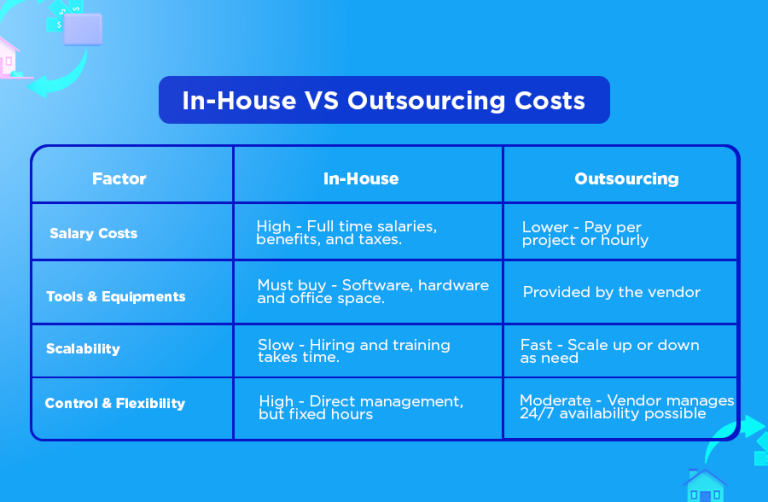Schedule a FREE call with our outsourcing expert now and get a precise quotation that meets your requirements. Don't wait - get started today!
Outsourcing is a strategic business decision that can significantly impact efficiency and growth, particularly for small and medium-sized enterprises (SMEs). While it may seem complex, understanding and managing outsourcing costs doesn’t have to be overwhelming.
As management expert Peter Drucker once said, “What gets measured gets managed.” This principle is especially relevant when outsourcing, as accurately measuring costs ensures better financial planning and smarter decision-making. Without a clear understanding of expenses, businesses risk overspending or failing to maximize the value of outsourcing partnerships.
This article will explain how to calculate outsourcing costs in a clear and easy way. By the end, you’ll know how to make the best choice for your business.
Breaking Down the True Cost of Outsourcing
Outsourcing can be a smart way to save money and improve efficiency. However, many businesses focus only on the immediate costs without considering all the financial factors involved. To get a clearer picture, it’s important to break down the direct, indirect, and opportunity costs of outsourcing.
A. Direct Costs: What You Pay Upfront and Ongoing Fees
Direct costs are the most obvious expenses when outsourcing. These typically include:
- Service fees – The amount you pay the outsourcing provider for their work. This could be a fixed monthly fee, an hourly rate, or a project-based cost.
- Setup costs – Some outsourcing providers charge for onboarding, system integration, or software setup.
- Technology and tools – If outsourcing requires specific software or hardware, you may need to cover those costs.
- Contract and legal fees – Drafting and reviewing outsourcing agreements may involve legal expenses.
While these costs are predictable, they vary depending on the outsourcing model and service provider.
B. Indirect Costs: Training, Onboarding, and Integration Expenses
Indirect costs are expenses that businesses don’t always consider upfront. These include:
- Training expenses – Even when outsourcing to experienced professionals, some level of training is often needed to align them with your processes and expectations.
- Transition time – It takes time to integrate an outsourcing partner into your workflow, which can temporarily slow down operations.
- Management and supervision – While outsourcing reduces workload, it still requires oversight to ensure quality and efficiency. Assigning an internal team to manage the outsourced function adds to the cost.
- Data security and compliance – Depending on the industry, additional security measures or compliance requirements may increase costs.
These hidden expenses can add up, making it essential to factor them into outsourcing decisions.
C. Opportunity Costs: What You Gain or Lose by Outsourcing
Opportunity cost refers to what your business could be doing instead of managing an outsourced task in-house. This includes:
- Focusing on core business activities – Outsourcing frees up time and resources, allowing businesses to concentrate on growth, innovation, and customer service.
- Faster scalability – By outsourcing, businesses can expand services without the delays of hiring and training in-house staff.
- Loss of control – While outsourcing has advantages, businesses may lose direct control over outsourced tasks, which can impact quality or customer experience.
- Brand reputation risks – Poor outsourcing decisions can affect brand reputation if the service provider does not meet customer expectations.
Understanding these costs helps businesses make informed outsourcing decisions. While outsourcing can reduce expenses and increase efficiency, evaluating direct, indirect, and opportunity costs ensures it truly benefits the business in the long run.
Key Factors to Consider When Calculating Outsourcing Costs
Calculating outsourcing costs isn’t just about adding numbers. It’s about understanding the factors that influence those costs. Here’s what you need to consider.
1. Service Level Agreements (SLAs)
The level of service you expect directly affects pricing. Providers offering faster response times, round-the-clock support, or strict compliance measures may charge higher fees due to the additional resources required to meet those standards.
2. Location of the Provider
Where your outsourcing partner is based can impact costs in multiple ways. Offshore providers often offer lower rates, but factors like time zone differences, language barriers, and cultural differences can lead to miscommunication or delays, which may increase indirect costs. Onshore providers tend to be more expensive but offer smoother collaboration and faster response times.
3. Level of Expertise
The complexity of the service you need determines the price. Basic administrative tasks may have lower costs, while specialized services, such as IT support, legal assistance, or high-level consulting, often require highly skilled professionals, leading to higher fees. Always ensure the provider’s expertise aligns with your business needs.
4. Contract Length
The duration of your agreement can impact pricing and flexibility. Long-term contracts may provide cost savings through discounts, but they can also limit your ability to switch providers if the service no longer meets your needs. Short-term contracts offer flexibility but may come with higher rates.
Why Calculating Outsourcing Costs Matters
Before jumping into the numbers, it’s important to understand why calculating outsourcing costs is essential. It’s not just about saving money—it’s about making smart decisions that align with your business goals. A well-planned outsourcing strategy ensures that you maximize efficiency, reduce risks, and get the most value for your investment.
-
Avoid Hidden Costs
Outsourcing might seem affordable at first glance, but unexpected expenses can quickly add up. Without a clear cost breakdown, you might overlook setup fees, training costs, contract penalties, or additional charges for extra services. These hidden costs can strain your budget and reduce the financial benefits of outsourcing. Proper cost analysis helps you avoid surprises and plan accordingly.
-
Budget Better
Knowing the exact cost helps you plan your budget and allocate resources effectively. It ensures that you don’t overspend on outsourcing while still having enough funds for other critical areas like marketing, product development, or employee salaries. A well-managed budget also allows for scalability, so you can adjust outsourcing expenses as your business grows.
-
Compare Providers Effectively
Not all outsourcing providers offer the same pricing, service quality, or contract terms. By calculating costs upfront, you can compare different providers based on both price and value. This helps you choose a provider that offers the best balance of affordability, reliability, and quality, ensuring that you don’t sacrifice service excellence for a lower price.
-
Measure ROI
Outsourcing is an investment, and understanding the costs helps determine whether it delivers real value. By calculating expenses and comparing them to productivity gains, time savings, or increased revenue, you can measure the return on investment (ROI). This ensures that outsourcing remains profitable for your business rather than a financial burden.

How to Calculate Outsourcing Costs
Now that you know why it’s important, let’s talk about how to do it. Here’s a step-by-step guide to help you calculate outsourcing costs like a pro. Taking the time to break down expenses ensures you stay within budget and get the best value for your investment.
1. Identify the Services You Need
Start by listing the tasks you want to outsource. Is it customer support, IT services, or back-office tasks? Clearly defining the scope of work helps you get accurate quotes from providers and ensures you only pay for what you actually need. Additionally, knowing the specific services required prevents overspending on unnecessary features.
2. Understand Pricing Models
Outsourcing providers use different pricing models, and choosing the right one can impact your overall costs. Some charge per hour, while others offer fixed rates or pay-per-task structures. Some even offer tiered pricing, where costs vary based on service level. Make sure you understand how they calculate costs to avoid surprises and ensure transparency in billing.
3. Factor in Setup Costs
Some providers charge a one-time setup fee, including training, software installation, or infrastructure setup. If your outsourced team needs special tools, licenses, or onboarding support, these costs can add up. Including setup fees in your cost calculation helps you determine the true initial investment required.
4. Consider Operational Costs
Think about the ongoing costs of outsourcing beyond the initial setup. This includes monthly service fees, software maintenance, transaction fees, or additional charges for scaling up services. Some providers may also have penalties for contract changes or early termination, so factor these into your long-term budget planning.
5. Calculate the Total Cost
Add up all the costs—setup, operational, and any hidden fees—to get the total cost of outsourcing. This final figure gives you a clear understanding of the financial commitment involved. Comparing this total with your expected benefits, such as cost savings or efficiency improvements, helps you decide whether outsourcing is the right choice for your business.
Common Mistakes in Calculating Outsourcing Costs
Even with the best intentions, mistakes can happen. Miscalculating costs can lead to budget overruns and unexpected expenses. Here are some common pitfalls to avoid when calculating outsourcing costs.
1. Ignoring Quality Over Cost
Choosing the cheapest option might save money upfront, but poor service quality can lead to missed deadlines, customer dissatisfaction, and costly rework. Always balance cost with quality to ensure you get reliable and efficient service. Investing in a slightly higher-priced provider with a proven track record can save you money in the long run.
2. Overlooking Transition Costs
Switching to an outsourcing provider takes time and effort, and the transition period often involves extra expenses. These costs could include training your provider, temporary productivity loss, and system integration. Failing to account for these can lead to budget miscalculations and unexpected financial strain.
3. Not Planning for Scalability
Your business will grow, and so will your outsourcing needs. If your provider cannot scale with you at a reasonable cost, you may need to switch providers, incurring transition costs again. Make sure your provider offers flexible plans that can adjust to your business growth without significantly increasing expenses.
4. Forgetting About Communication Costs
Working with an offshore team might involve additional communication costs, such as collaboration tools, video conferencing software, or even occasional travel for in-person meetings. If these expenses are overlooked, they can add up and impact your overall outsourcing budget.
Industry-Specific Outsourcing Cost Considerations
Different industries have unique cost structures when it comes to outsourcing. Understanding these variations can help businesses plan more effectively. Here’s a closer look at some common outsourcing industries.
Call centers charge based on different models: per hour, per call, or per agent. Businesses must decide which pricing structure aligns with their needs to avoid overpaying or underutilizing services. Additional factors such as 24/7 availability, multilingual support, and service level agreements (SLAs) also influence the final cost.
1. IT and Software Development
Technology outsourcing involves licensing fees, security expenses, and ongoing maintenance. Ignoring these costs can lead to security risks and expensive system failures. Businesses must also consider cloud services, software updates, and compliance with data protection regulations to avoid costly legal issues.
2. E-commerce and Customer Support
Customer service outsourcing requires software integrations, agent training, and multilingual support. Pricing can vary based on response times, customer volume, and required technical expertise. Businesses should factor in CRM (customer relationship management) software costs, chatbot implementation, and seasonal demand fluctuations.
3. Accounting and Payroll Services
Finance-related outsourcing involves compliance costs, regulatory fees, and software subscriptions. Failing to account for local tax laws and financial reporting standards can lead to penalties and legal trouble. To avoid unexpected expenses, businesses should ensure their outsourcing provider adheres to industry-specific compliance standards.
Using an Outsourcing Cost Calculator
If math isn’t your strong suit, don’t worry. Many tools can help you calculate outsourcing costs. These calculators streamline the process and minimize errors. Here’s how an outsourcing cost calculator can make your life easier.
-
Saves Time
A calculator does the heavy lifting for you. Instead of manually computing every cost, you can input the necessary figures, and it will generate the total cost in seconds. This speeds up decision-making and allows businesses to focus on other priorities.
-
Reduces Errors
Manual calculations can lead to mistakes, especially when dealing with multiple cost components. A calculator ensures accuracy by automating the process, reducing the risk of overlooking hidden expenses. This helps prevent budget miscalculations.
-
Provides Clarity
Seeing the breakdown of costs helps you understand where your money is going. Many calculators offer detailed reports that categorize expenses, making it easier to analyze spending and adjust plans if needed.
-
Helps with Comparisons
You can use the calculator to compare different providers based on pricing, service levels, and additional fees. This way, you can choose the one that fits your budget and meets your business needs without unnecessary guesswork.
A study by Deloitte found that 59% of businesses outsource to cut costs, while 57% do it to better focus on core functions. This proves that cost savings are a primary driver, but financial planning remains critical.
Outsource Smart, Spend Wisely
Accurate outsourcing cost calculation leads to smarter financial decisions. Magellan Solutions offers transparent pricing and tailored solutions to ensure you get the best value. Book your FREE 60-minute business consultation today—no commitments, just expert insights on optimizing your outsourcing strategy.
With 19+ years of experience, we’ve helped SMEs streamline operations, reduce costs, and improve efficiency. Our services include call center outsourcing, back-office support, and IT solutions, all designed to fit your unique needs. Plus, we guide you through the process, ensuring clarity every step of the way.
Get a FREE 60-minute consultation with our experts. We’ll help you analyze costs, compare options, and develop a strategy that works for your business. No commitments—just practical insights to help you make the best decision.
















